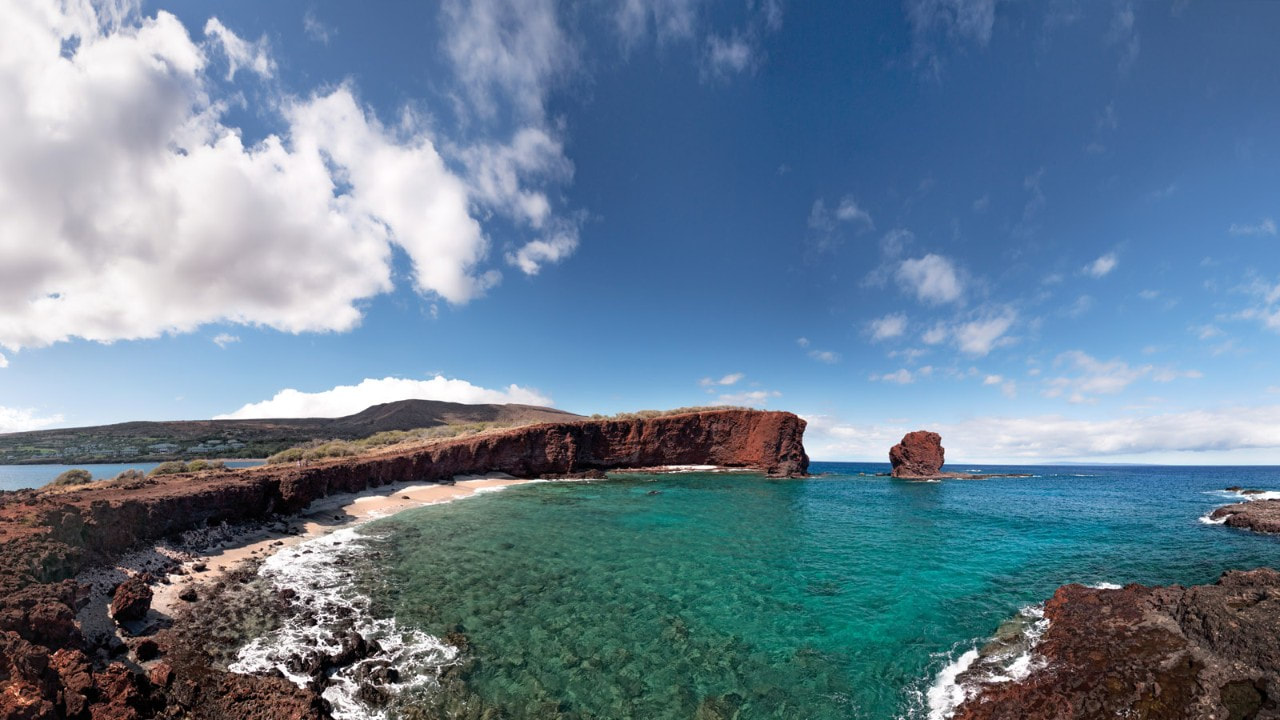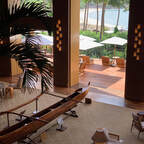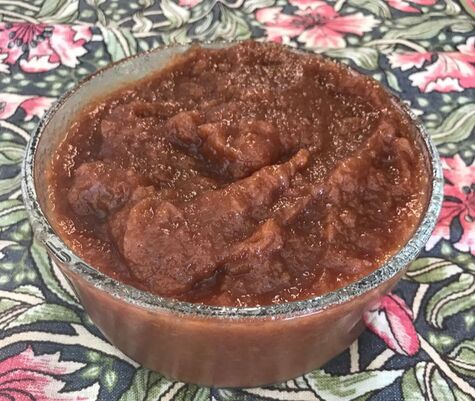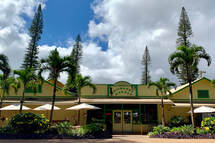Lanai is the driest of all the Hawaiian Islands, and its lava rock landscape, covered with scraggly acacia trees, presents an otherworldly aspect. Closer observation startles the visitor with the presence of non-native species mingling among the sparse original plants and animals. The most notable newcomers are the Cook Island Pines, hundreds of them, planted in neat rows along the very few roads on the island and inhabiting the town square of the island’s only town, Lanai City. The first pine, a Norfolk Pine, was planted on the island in 1878, and the Cook Island Pines quickly followed. Their purpose was to increase rainfall in this very dry environment by sucking moisture out of the clouds and fog with their highest branches.
Other unexpected non-native inhabitants include wild turkeys and deer, both Axis Deer and Black Tail Deer, all of these apparently imported for the pleasure of hunters. This importation of non-native plants and animals coincides with the gradual take-over of land ownership from native Hawaiians to mainland American businessmen. Beginning in 1848, King Kamehameha III offered land grants to native Hawaiians, and it wasn’t long before unscrupulous businessmen managed to wrest this land out of native hands. Walter Gibson pulled off one of the more dubious land deals in the 1870s by embezzling funds from the Mormon Church, then headed by Brigham Young, on the pretext of establishing a Mormon colony on Lanai. Gibson bought almost all of Lanai from a Hawaiian Mormon and placed the land in his own name, leading to his excommunication but making him the single largest landowner on the island.
Eventually, the Dole corporation merged with Castle and Cooke, from whom American businessman Larry Ellison purchased 98 per cent of Lanai in 2012. Two percent of the island is still owned by the State of Hawaii, and Lanai is part of Maui County. Ellison’s focus since buying the island has been on tourism. Ellison has made some improvements for the local community, including renovating the movie theater in Lanai City, adding a new water filtration system and building a public swimming pool. He has also invested 450 million dollars to remodel the Four Seasons Resort Lanai at Manele Bay and is currently turning the Four Seasons Resort at Koele in the mountains into a world-class health and fitness spa. At the time that he bought the island, Ellison stated that he wanted to make Lanai, “the first economically viable 100 percent green community.” So far, the only effort toward realizing this goal is the announcement of a hydroponics venture that has not yet gone into production. However, Ellison has built several luxurious homes to accommodate his friends and family when they visit the island.
Today, many of the local residents of Lanai work either for the Four Seasons Resorts, Pulama Lanai, (Ellison’s ownership corporation,) or related tourism activities. This brings us to my most recent visit to Lanai only last month. I was about to celebrate a very significant birthday, and my sister-in-law Joyce Higashi, who formerly worked for Pulama Lanai, suggested that we make a quick trip to Lanai prior to a Higashi family reunion scheduled to take place at our home on Oahu the following day. When we first moved to Hawaii, my husband Wayne and I made the decision, with Joyce’s assistance, to donate our Sulfur-Crested Cockatoo, Crystal, who had lived with us for thirty years, to the Four Seasons Resort on Lanai.
We knew that eventually we would need to find a new home for Crystal, as cockatoos can live for ninety to one hundred years. We had stayed at the Four Seasons Manele Bay and the Four Seasons Koele on previous occasions and were familiar with the Four Seasons policy of housing exotic birds at their tropical resorts. Our move to Hawaii presented a perfect opportunity for Crystal to move too. As an employee of Pulama Lanai at the time, Joyce was ideally suited to facilitate Crystal’s move to Lanai. Joyce worked with the Peninsula Humane Society in the San Francisco Bay Area, which is equipped to house tropical birds. The Humane Society managed Crystal’s health care and quarantine before she was allowed to travel to Hawaii. And once Crystal moved to the Four Seasons, Joyce checked on her frequently to make sure she was happy and well cared for.
Crystal is indeed a happy bird, though at our recent visit with her at the Four Seasons, we discovered that she is a male and her new name is Haouli, meaning “Happy” in the Hawaiian language. We had several delightful visits with Haouli and his devoted caretaker, Bruno, and we were pleased that our former bird still remembered us and was happy to talk to us. He kissed Wayne on the cheek and eagerly hopped onto his shoulder and lifted his wings to be petted. Bruno told us that the veterinarians who work for the Four Seasons had administered a DNA test to determine that Haouli is a male, as male and female cockatoos cannot be distinguished visually. Haouli lives in a spacious enclosure surrounded by tropical plants in the evenings, and Bruno brings him out on his perch along with two African Gray Parrots during the day so the guests can interact with him. Two cute young French sisters were admiring him when we arrived. And we discovered that Haouli still loves California almonds, which Bruno was hand feeding him.
The renovated Four Seasons Manele Bay is a beautiful resort, tastefully and elegantly furnished with lush tropical landscaping, including fragrant blossoming trees and flowers surrounding every room and public area. Though it is a large hotel complex, the designers have created a sense of intimacy by dividing the space into small gathering areas with several intimate swimming pools rather than one large pool. There is also a feeling of respect for the natural habitat and history of the area, as an ancient Hawaiian village archeological site remains on the resort property facing the ocean. Hawaii state law and the Maui County Historic Places Review Board may have required the preservation of this site.
As lovely as the Four Seasons Manele Bay is, the more than one thousand dollars a night room rate makes it unaffordable for normal family vacations. For our night on Lanai, we chose the only other option on the island, the beautifully refurbished historic Hotel Lanai, owned by Pulama Lanai. Built in 1923 by James Dole of pineapple fame, this ten-room wooden plantation style structure was once used as a retreat house for top Dole executives. In addition to the attractively appointed rooms, the hotel houses a ninety-seat restaurant, the Lanai City Bar and Grille, and a one-bedroom cottage on the pine-dotted grounds.
From the moment of our arrival at Hotel Lanai, I was reminded how many friends my sister-in-law still has on the island. The hotel manager, Sarah, sent freshly baked cookies to our room and loaned us a copy of Images of America: Lanai by Alberta de Jetley to help us familiarize ourselves with our surroundings. In our rooms, Wayne and I as well as Joyce, found generous gift baskets filled with high-end chocolate covered macadamia nuts and other local goodies sent by Harrilynn Kame’enui, Senior Vice President of Administration and Legal Affairs and General Counsel of Pulama Lanai. At dinner that evening at the Lanai City Bar and Grille, several of Joyce’s other former co-workers also dropped by our table to greet her and welcome her back. Among those well-wishers was Kurt Matsumoto, Chief Operating Officer of Pulama Lanai.
Our dinner at the Grille was delicious. The menu of this lively and busy place is packed with luscious local ingredients, either locally sourced or brought over on the weekly barge from Maui. We enjoyed Corn Bisque poured over mini Crab Cakes with Pepper Jelly as a starter, and Wayne had Venison with Mashed Potatoes and a dark and very flavorful Wine Sauce. I had a very tasty Mushroom Risotto, and Joyce had a beautiful Harvest Salad loaded with fresh greens and vegetables and an unusual and subtly flavored Ceviche with Sweet Potatoes.
To cap off my birthday, we returned to our room and enjoyed home-made Butter Mochi in the wooden rocking chairs on our private front porch. The Butter Mochi, one of the most popular desserts in all of the Hawaiian Islands, was another gift from one of Joyce’s former co-workers, Nalani Silva, Executive Assistant at the Four Seasons Manele Bay. After we devoured my “Hawaiian Birthday Cake,” the night was still young, so we decided to walk one block over to the town square and take in a first-run movie at the newly refurbished theater. Whom should we happen to meet there but Crystal/Haouli’s caretaker, Bruno and his wife? Lanai is truly a very small and friendly place.
On our final morning on the island, we took a leisurely stroll around the square to visit the shops, markets and restaurants, some still old and funky and some newly refurbished with the assistance of Pulama Lanai. Richard’s Market, which has been in business for a long time, has been updated to cater to the visitors in Ellison’s private homes and now resembles a sort of mini Whole Foods, with a large wine selection and plenty of freshly prepared foods including, rotisserie meats, poke, salads and desserts.
Mike Carroll Gallery, housed in small rickety plantation style home, is another mainstay of Lanai City. Here visitors can purchase oil paintings, many depicting local outdoor scenes, including many by the owner, Mike Carroll himself. Prints and greeting cards are also available as is the book on Lanai’s history, landscape and culture by Alberta de Jetley, Images of America: Lanai. This local author was born on Molokai and sent to school on Lanai where she graduated from high school in 1963. Today, Alberta is the publisher and founder of Lanai Today, a community newspaper she established in 2008.
Other businesses and services on the town square include the Post Offfice, Court House, Public Library and a few coffee shops, restaurants and clothing stores. After viewing all of these, we still had time for a quick final visit with Crystal and Bruno at the Four Seasons, where Joyce’s friend Nalani (of Butter Mochi fame,) generously took us on a guided tour of the resort, including a visit to one of the guest rooms, refurbished in water-resistant and durable but very expensive ipe wood.
We were waiting for the number one tourist destination on Lanai to open at 10:00 AM: The Lanai Cat Sanctuary. Founded in 2009 by Kathy Carroll, wife of the artist Mike Carroll, the Cat Sanctuary began with twenty-five rescued feral cats and now cares for more than 600 cats in a spacious and comfortable 3.5 acre enclosure filled with chairs, tables, ladders, beds, and every imaginable toy and comfort that a cat’s heart might desire. All of the cats are from Lanai, and all are spayed or neutered. They are fed, cared for, given veterinary care and loved by the enthusiastic staff and volunteers. The organization is happy to accept donations for this worthy cause. The Cat Sanctuary also has a commitment to protecting local birds.
After less than twenty-four hours on lovely Lanai, we returned to our beach house on Oahu to welcome eleven of Wayne and Joyce’s family members. I hope that the hospitality we offered our relatives was as warm as we received on Lanai. This ancient island has seen so many changes, from an indigenous lifestyle to ranching, pineapple farming to tourism, yet the people remain steady in their values and kind.
On our recent visit, it appeared to me that the new owner of Lanai’s goal is to create a playground for the uber-wealthy on remote Lanai with a built-in workforce comprised of the grandchildren of plantation workers. Pulama Lanai’s website states the corporation’s goal as “Promoting Progress and Sustainability on Lanai,” and their Facebook page describes Pulama Lanai as an “Environmental Conservation Organization.” Is this true?
In an article published in 2018, Kristine DeMaria, states, “For the environmentally conscious architect or designer, avoiding ipe is a must. If you prioritize sustainability in your projects, ipe is a wood to avoid.” Yet ipe, which has been overharvested and is in danger of extinction, is the wood that was used in the recent remodel of the Four Seasons Manele Bay. This is only one example, but how exactly does a high-end resort developer earn his claim to be an “environmental conservationist,” especially when rumor has it that he plans to build a third resort on pristine land on the east side of the island? Perhaps only the people of Lanai are qualified to answer this question, and only they know whether their lives are better now that a billionaire entrepreneur from California owns 98 percent of their homeland.
I invite you to review our “Hawaiian Tea” in “The Tea Book” section of this website (myteaplanner.com) under the tab “A World of Tea Parties.” This menu will introduce you to the basics of Hawaiian Food and to another favorite Hawaiian Dessert: Haupia, or Coconut Gelatin Pudding. Butter Mochi is just as popular with Hawaiians, as it includes mochiko, or sticky rice flour, which is used to make so many Hawaiian and Japanese desserts. The texture of Butter Mochi is pleasantly chewy. A big Mahalo (Thank You in Hawaiian) to my friend Diana Blanco for her special Butter Mochi recipe.
Special equipment: large mixing bowl, wooden spoon, 13”by 9” rectangular baking pan, sprayed with cooking spray, wire cooling rack, sharp knife
Makes: 12 or more servings
Preheat oven to 350° F
- 1 box mochiko flour
- 2 teaspoons baking powder
- 1 ½ cups evaporated milk
- 5 eggs
- 1 can coconut milk (about 1 ½ cups)
- 1 cup white sugar
- 1 cup golden brown sugar
- 1 teaspoon vanilla extract
- ½ cup (1 cube) butter, melted
- Cooking spray for the pan
- Combine all of the ingredients except the butter in a large bowl and stir with a wooden spoon. Add the melted butter and stir until incorporated. Pour into the prepared pan and let stand for 5-10 minutes. Bake in the pre-heated oven for 1 hour.
- Remove to a wire rack to cool. With a sharp knife, cut into squares and serve warm or at room temperature. Refrigerate leftovers. Can also be served chilled.























 RSS Feed
RSS Feed